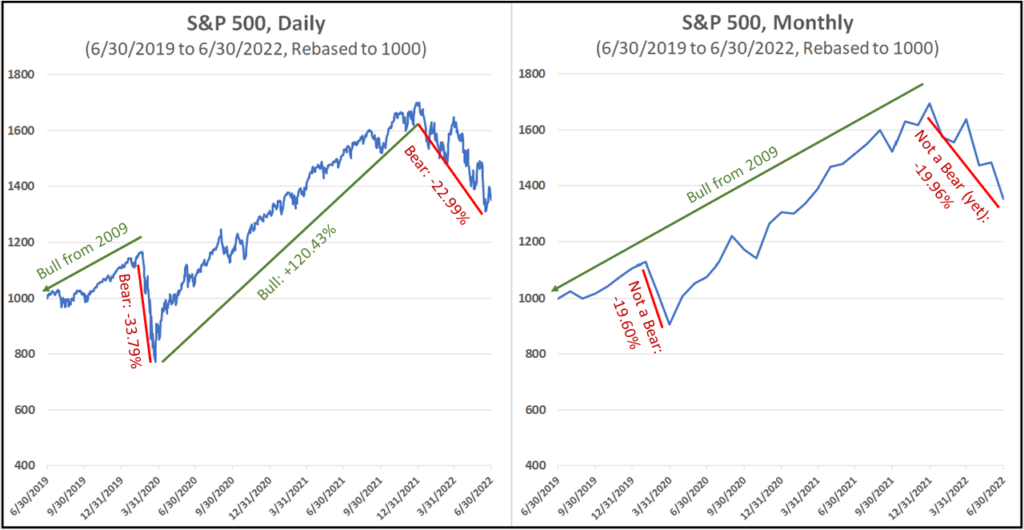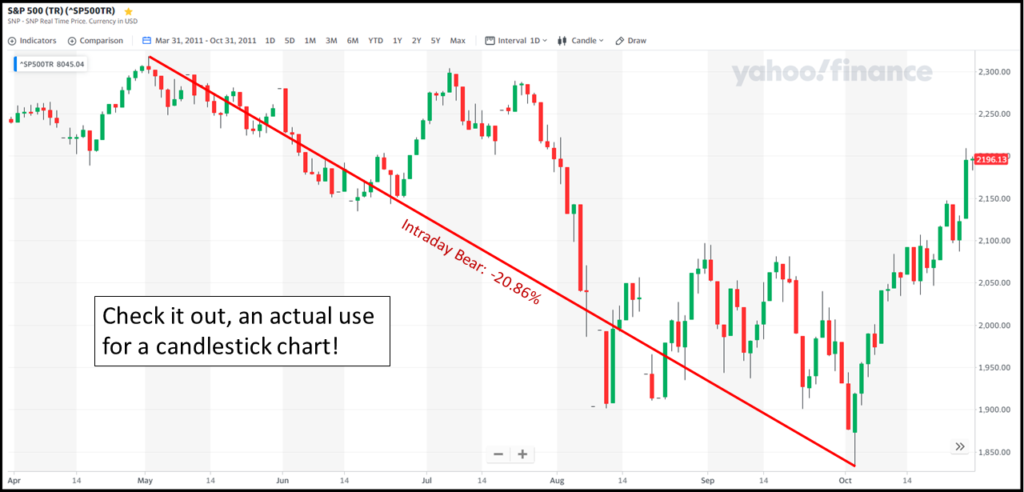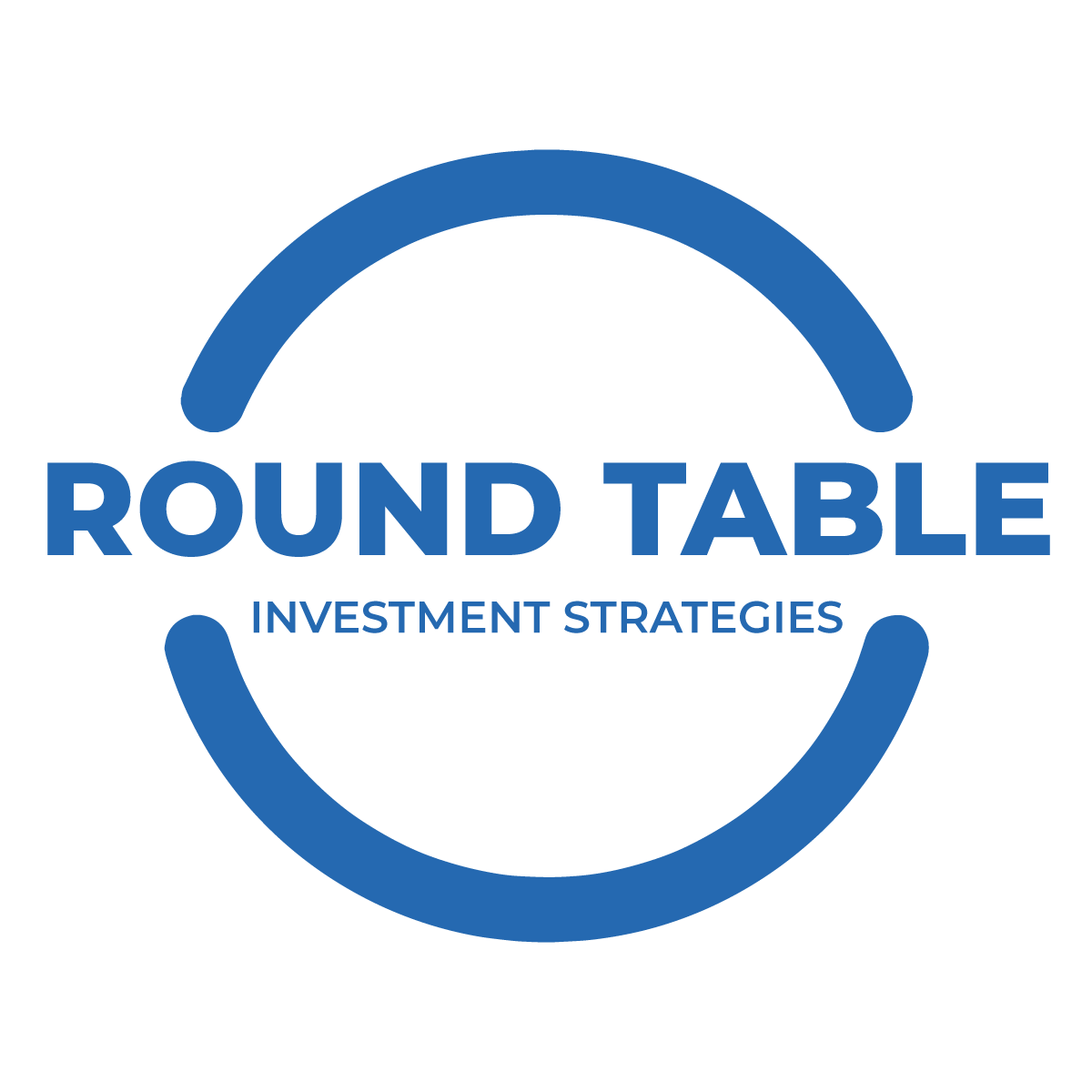This is mostly just a curious anomaly:
- When measured using daily data, the S&P 500 Index[1] (the usual stand-in for “the stock market” in the U.S.) is in its second bear market in just over two years.
- When measured using monthly data, the S&P 500 is still in a historic bull market that stretches all the way back to 2009.
Check it out!

https://finance.yahoo.com/quote/%5ESP500TR/history?p=%5ESP500TR (data)
The 2020 Covid backdrop is the more interesting of the two daily-only bear markets, for two reasons:
- In 2020, the S&P 500 fell 33.79%, yet because the entire drop began on February 20 and ended on March 23, with the subsequent sharp recovery kicking off in the second half of March, the monthly drawdown (from December 31, 2019 to March 31, 2020) was only 19.60%…fourteen percentage points less severe than the dailies!
- The current drawdown is nowhere near recovery yet, and the tiniest drop for the month of July could push us into bear territory by either definition.
Regardless, for now, this strange quirk persists.
Why Would Anyone Use Monthlies?
In the moment, we all interest ourselves in day-to-day stock market changes, and commentators don’t wait until the end of the month to determine whether a bear market is underway. So why care about monthlies?
One reason this is interesting is that reliable historical total return[2] S&P 500 figures are only available on a daily basis going back a few decades. So any studies that look at long-run historical stock market data (on bear markets or otherwise) will likely use monthlies for apples-to-apples comparisons. Ironically, we even used monthly data in our analyses in the article Round Table posted when this (so far daily-only!) bear market started.
For that matter, what’s so special about daily (i.e., end-of-day) data? On an intraday basis, for example, the post-Great Financial Crisis bull market ended in just two and a half years, with a 20.86% drop from the highs on May 2, 2011 to the lows on October 4, 2011…but good luck finding anyone who views that as the end of the bull run!

Random, Scattershot Takeaways
Again, this is mostly just a crazy factoid, but a few thoughts spring forth half-baked from my stream of consciousness. In no particular order:
- Every industry needs its jargon, its benchmarks, its definitions. Finance is no exception. But there’s nothing fundamentally meaningful about the bull/bear market definition. Are you doing better if it’s a (monthly) bull market? Are you doing worse if it’s a (daily) bear market? Of course not! And how many investors’ entire equity portfolios are specifically tied to the S&P 500 anyway?
- That doesn’t render the bull/bear market notion inconsequential. The real point is that markets can and sometimes do lose a decent chunk of change. A 20% drop is as good a marker as any other random-but-sizable selection to serve as a baseline for analyzing “large losses” for historical context, portfolio design, risk management, blog post authoring, etc. The funny fact we’ve uncovered here just tells us not to take that 20% figure too seriously.
- This is a good example of how you can “massage” data to tell the story you want. Positive vibes? Go monthly. Negative clickbait? Go daily. This might be a slightly sillier example than what you’ll see in real life…but honestly not much sillier. Remember that the primary goal of financial journalism is to get your eyeballs on it.
- Holy cow, that 2020 volatility was insane! A nearly 34% drop in 23 market days, followed by a return to all-time highs in less than 5 months?! Mamma mia!
- Apropos of the last two bullet points: We’ve seen commentators speak about the current drawdown as “the longest bear market since the Great Financial Crisis” or something to that effect. Which is true, but, like, that 2020 Covid crisis was the only other bear market since 2008 and it was ridiculously brief. Admittedly there’s no telling how long the current bear market will last, but thus far its duration has merely cleared a comically modest hurdle.
- Sorry, I have to revisit this: We have three different definitions, by which the post-2008 bull market lasted: 2.5 years (intraday)…nearly 11 years (daily)…or 13+ years and counting (monthly). Who cares whether this is important? It is gloriously bizarre!
- The calculations in this article use a “total returns” index, which incorporates both stock price changes and dividends into the index return. You’ll commonly (perhaps usually) see a “price returns” version of S&P (or other indices), which ignores dividends. The only thing price return indices have going for them is that they’re easier to calculate. That’s better work hours for the index provider, not better data for you. Investors get to keep their dividends too![3]
- I mention this because the S&P 500 price return index actually was down 20.00% from 12/31/2019 to 3/31/2020 and 20.58% from 12/31/2021 to 6/30/2022. So this article could have been, “Use Total Returns, It’s a Bull. Use Price Returns, It’s a Bear.”[4]
- Another scary headline you might see will proclaim that this is “THE WORST FIRST HALF IN A HALF CENTURY”![5] This really just points out the very odd fact that the market’s truly ugly periods[6] have tended to stick to the second half of the year.
- Side note: The whole “sell in May and go away” baloney comes from the latter observation. We’ll probably write a whole article on that one eventually, but suffice it to say we don’t consider “sell in May” to be good advice. Mark Twain got the “risk” part of risk/return right: “October. This is one of the peculiarly dangerous months to speculate in stocks. The others are July, January, September, April, November, May, March, June, December, August, and February.”[7] But that very risk is what makes the stock market such a high expected return investment!
- While we’re at it, we’re seeing a lot of “Unprecedented…” in the financial press as present. Just keep in mind that the more things they had to stack on top of each other (“Unprecedented to have a bear market with high inflation while there’s a land war in Eurasia and high gas prices under a president whose last name starts with B in a calendar year with three 2’s…”), the harder they had to work to find something that hadn’t happened before. You can always find something unique about a given market backdrop. But as Mark Twain may or may not also have said, “History doesn’t repeat itself, but it often rhymes.”[8]
- Finally, we quote ourselves. This is how we believe stock market investing should be viewed, now as always:
- The stock market is always priced for positive expected return, indeed for a substantially higher return than can be expected from less risky securities, such as bonds.
- The higher expected return is compensation for ever-present risk, such that it is always possible for stocks to underperform or even lose value instead.
Those twin truths are (1) why those with the capacity for investment risk may have good reason to take that risk by investing in stocks, and (2) why a solid financial plan should be the guide for determining how much risk capacity someone really has!
Please feel free to contact Round Table to learn more about how we view strategic financial planning and investment management as two sides of the same coin.
[1] S&P 500 Index owned by S&P Global. Data in this article from Yahoo! Finance (https://finance.yahoo.com/quote/%5ESP500TR?p=%5ESP500TR, https://finance.yahoo.com/quote/%5EGSPC?p=%5EGSPC) and Dimensional Fund Advisors. All calculations by Round Table Investment Strategies.
[2] I.e., incorporating both price movements and dividends. More information in subsequent bullet points.
[3] This is not some minor technicality. Over the past, say, 50 years, the price return version of S&P (which treats dividends like lost money) has returned 3,433% (7.39% annualized) and the total return version (which includes dividends, reinvested) has returned 14,718% (10.51% annualized). Do you want most of your money or don’t you?!
[4] As long as we’re talking about monthlies and not dailies! With dailies it’s a bear either way.
[5] Those same articles inevitably use the afore-maligned price return version of S&P, because, after all, that better suits the fearful tone!
[6] For example, on “Black Monday” (October 19, 1987), the S&P 500 Index lost more value (-20.5%) in a single day than it lost in 2022’s entire “worst first half in 50 years.”
[7] Mark Twain, Pudd’nhead Wilson, https://www.goodreads.com/quotes/322301-october-this-is-one-of-the-peculiarly-dangerous-months-to
[8] Okay, probably not. See this article from the fabulous Quote Investigator website: https://quoteinvestigator.com/2014/01/12/history-rhymes A more certain quote from Twain is included: “History never repeats itself, but the Kaleidoscopic combinations of the pictured present often seem to be constructed out of the broken fragments of antique legends.” I suppose this makes up in grandiosity what it loses in pithiness.
DISCLOSURES: All content is provided solely for informational purposes and should not be considered an offer, or a solicitation of an offer, to buy or sell any particular security, product, or service. Round Table Investment Strategies (Round Table) does not offer specific investment recommendations in this presentation. This article should not be considered a comprehensive review or analysis of the topics discussed in the article. Investing involves risks, including possible loss of principal. Despite efforts to be accurate and current, this article may contain out-of-date information, Round Table will not be under an obligation to advise of any subsequent changes related to the topics discussed in this article. Round Table is not an attorney or accountant and does not provide legal, tax or accounting advice. This article is impersonal and does not take into account individual circumstances. Reading this article does not create a client relationship with Round Table. An individual should not make personal financial or investment decisions based solely upon this article. This article is not a substitute for or the same as a consultation with an investment adviser in a one-on-one context whereby all the facts of the individual’s situation can be considered in their entirety and the investment adviser can provide individualized investment advice or a customized financial plan.
The data shown in this article is for informational purposes only and should not be considered as an investment recommendation or strategy, or as an offer to buy or sell any particular security, product, or service. Past performance may not be indicative of future results. While the sources of data included in any charts/graphs/calculations are believed to be reliable, Round Table cannot guarantee their accuracy.
